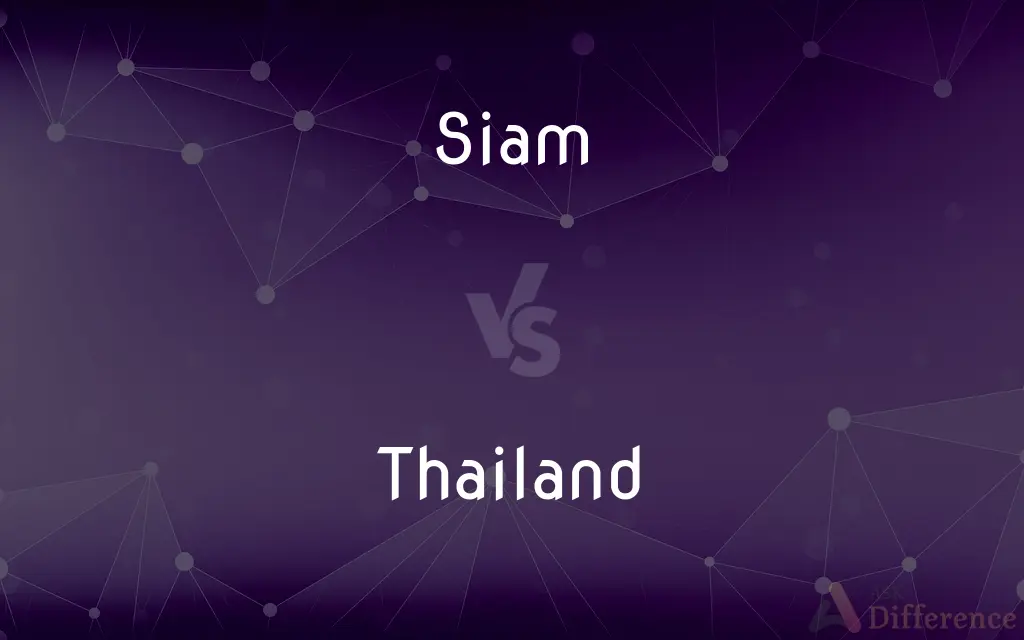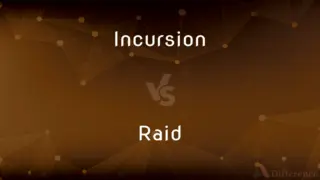Siam vs. Thailand — What's the Difference?
By Tayyaba Rehman & Maham Liaqat — Updated on March 18, 2024
Siam and Thailand refer to the same country in Southeast Asia, known for its rich history, culture, and natural beauty. The primary difference lies in the name: "Siam" was the country's official name until June 23, 1939, when it was changed to "Thailand."

Difference Between Siam and Thailand
Table of Contents
ADVERTISEMENT
Key Differences
Siam is a name that resonates with history, evoking images of a time when the kingdom was a major power in Southeast Asia, known for its unique culture, language, and monarchy. Thailand, meaning "land of the free," reflects the country's pride in being the only Southeast Asian nation never to have been colonized by a European power.
The name "Siam" is believed to have originated from the Sanskrit word "Syama," meaning "dark" or "brown," referring to the people or the land. It was the name by which the country was known to outsiders, particularly Europeans, from the 16th century onwards. The name Thailand change was part of a broader movement of nationalism and modernization under the leadership of Field Marshal Plaek Phibunsongkhram (Phibun), aiming to foster a sense of unity and identity among its people.
While "Siam" conjures images of the country's ancient and royal past, "Thailand" emphasizes its national identity and sovereignty. The transition from Siam to Thailand marked a significant shift in how the nation viewed itself and how it wanted to be perceived internationally.
The change from Siam to Thailand is not just about a change in name; it reflects a pivotal moment in the country's history, symbolizing a move towards modernization and a new era of self-determination. Despite the name change, the rich history and cultural heritage of Siam continue to be a cherished part of Thailand's identity.
Comparison Chart
Name Usage
Official name until 1939, and briefly between 1945-1949.
Official name since 1949.
ADVERTISEMENT
Historical Context
Associated with the kingdom's ancient and royal past.
Reflects nationalism and the move towards modernization.
Meaning
Believed to originate from Sanskrit "Syama," meaning "dark" or "brown."
Means "land of the free," emphasizing national sovereignty.
International Relations
Name known by outsiders, especially Europeans, in historical contexts.
Adopted to foster a unified national identity on the global stage.
Cultural Significance
Evokes images of historical Siam, its culture, and monarchy.
Symbolizes Thailand's pride in its never-colonized status and modern identity.
Compare with Definitions
Siam
Refers to the rich cultural and royal history of Thailand.
Traditional Siamese art and architecture are major tourist attractions.
Thailand
Highlights the nation's pride in never having been colonized.
Thailand's history of independence is a source of national pride.
Siam
The period when the country was known as a powerful kingdom.
Siam was renowned for its diplomacy in the colonial era.
Thailand
Reflects the country's journey towards modernization and unity.
Thailand has emerged as a major economy in Southeast Asia.
Siam
The name by which European traders and explorers knew the country.
European maps from the 16th century often labeled the region as Siam.
Thailand
The official name of the country since 1949.
Thailand is famous for its breathtaking beaches and vibrant culture.
Siam
The name used for Thailand before 1939 and briefly from 1945 to 1949.
The ruins of Ayutthaya offer a glimpse into the grandeur of ancient Siam.
Thailand
Encompasses the modern cultural practices and innovations.
Contemporary Thai cuisine blends traditional flavors with modern culinary techniques.
Siam
A term that evokes the country's ancient past and traditions.
The Siamese cat, a native breed, is known for its elegant features and history.
Thailand
The name under which the country participates in international affairs.
Thailand is a member of ASEAN and contributes to regional cooperation.
Siam
Get lost!
Thailand
Thailand (Thai: ประเทศไทย), known formerly as Siam and officially as the Kingdom of Thailand, is a country in Southeast Asia. It is located at the centre of the Indochinese Peninsula, spanning 513,120 square kilometres (198,120 sq mi), with a population of over 66 million people.
Siam
A country of southeastern Asia that extends southward along the Isthmus of Kra to the Malay peninsula;
Thailand is the official name of the former Siam
Thailand
A country of southeastern Asia that extends southward along the Isthmus of Kra to the Malay peninsula;
Thailand is the official name of the former Siam
Common Curiosities
Can the terms "Siam" and "Thailand" be used interchangeably?
While they refer to the same country, their usage depends on historical context. "Siam" refers to the country's past, while "Thailand" is its current and official name.
Why was Siam renamed to Thailand?
The name change to Thailand was part of a nationalism and modernization effort, reflecting the country's independence and unity.
Does "Siam" still have relevance today?
Yes, "Siam" remains an important part of Thailand's history and cultural identity, often used in historical and cultural contexts.
How do Thais view the name "Siam" today?
Many Thais view "Siam" with nostalgia and pride, as it represents their rich history and cultural heritage.
What is the significance of the name "Thailand"?
The name signifies the nation's status as the "land of the free" and its pride in never having been colonized.
Has the transition from Siam to Thailand impacted its cultural heritage?
The transition reflects the country's modern identity, but Thailand continues to cherish and preserve its cultural heritage from the Siam era.
How did the name change affect Thailand's international relations?
The name change was a move to present a unified national identity to the world, enhancing its sovereignty and status on the global stage.
What historical events marked the era of Siam?
The era of Siam is marked by significant events such as the establishment and fall of the Ayutthaya and Sukhothai kingdoms, and interactions with European colonial powers.
Was there any opposition to the name change?
The name change was generally accepted as part of broader reforms, but it also faced criticism from some quarters for various reasons, including the loss of historical identity.
What role did Phibun play in the name change?
Field Marshal Plaek Phibunsongkhram, or Phibun, was a key figure in the name change, advocating for nationalism and modernization.
How has Thailand maintained its cultural heritage from the Siam period?
Thailand has maintained its cultural heritage through preservation efforts, cultural celebrations, and education, ensuring that the legacy of Siam continues to enrich the nation.
How does the name "Thailand" reflect the country's identity?
"Thailand" reflects the country's identity as a sovereign, independent nation with a rich cultural legacy and a forward-looking perspective.
What are some iconic symbols from the Siam era?
Icons from the Siam era include the Grand Palace in Bangkok, traditional Thai dance, and the Siamese cat.
How is the history of Siam taught in Thailand?
The history of Siam is an integral part of Thailand's educational curriculum, highlighting its significance in shaping the nation's identity.
What role does the monarchy play in Thailand's identity from Siam to Thailand?
The monarchy is a cornerstone of Thailand's identity, providing continuity and unity from the Siam era through to modern Thailand.
Share Your Discovery

Previous Comparison
Newsletter vs. Newspaper
Next Comparison
Incursion vs. RaidAuthor Spotlight
Written by
Tayyaba RehmanTayyaba Rehman is a distinguished writer, currently serving as a primary contributor to askdifference.com. As a researcher in semantics and etymology, Tayyaba's passion for the complexity of languages and their distinctions has found a perfect home on the platform. Tayyaba delves into the intricacies of language, distinguishing between commonly confused words and phrases, thereby providing clarity for readers worldwide.
Co-written by
Maham Liaqat















































